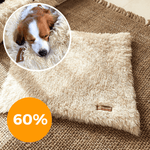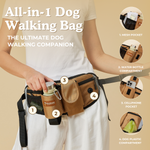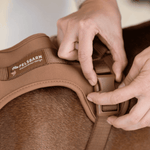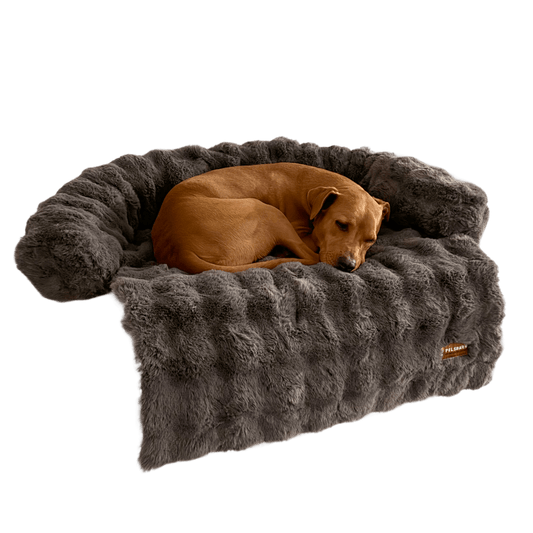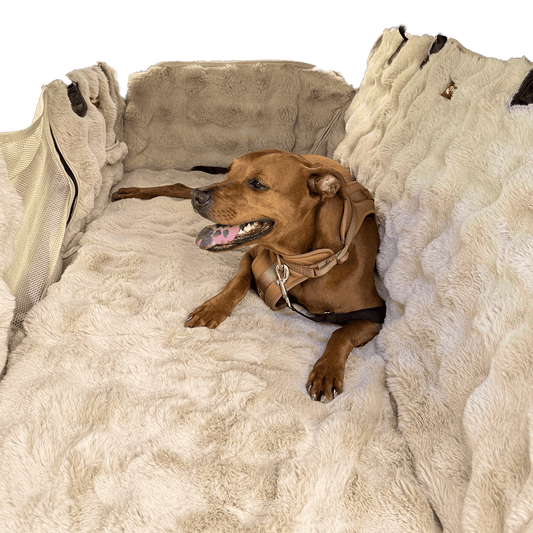Big dogs, big hearts and big bodies to support
There’s something undeniably majestic about large dogs. Their presence is calming, their steps powerful, and their love as steady as their stride. However… beneath all that strength lies a sad but simple biological truth: the bigger the body, the heavier the load on the joints that carry it.
Even though large breeds are built with bigger bones and thicker joints, their size creates mechanical challenges that smaller or medium sized dogs simply don’t face. Over time, that added stress can affect comfort, mobility, and long-term joint health. Especially as they age.
Explaining the physics and biology of our friendly furry giants
At first glance, it seems logical that large dogs should handle their own weight just fine. After all, they have bigger bones and larger joints to support them. And partially, that’s true: their skeletons do scale up proportionally with their size. But here’s the catch:
-
Bone and cartilage strength don’t increase indefinitely with size.
When an animal grows larger, its body weight increases with volume, while its joint surface area increases only with area. This relationship is known as the square–cube law, first described by Galileo and confirmed by modern biomechanics.
There’s a biological ceiling on how dense or thick these tissues can get before they become inefficient to move. That’s why evolution rarely sustains extremely large carnivores, partly because biomechanics and energy demands make it difficult to balance mass, agility, and hunting efficiency, and why breeds like Great Danes or Mastiffs, bred for size, often sit right on that mechanical threshold. If a dog doubles in height, its body weight increases about eight times, while the area over which that weight is distributed increases only four times.
That mismatch means each square inch of joint cartilage in the larger dog must carry roughly twice the stress.
Over years of movement, this constant mechanical load gradually wears down the cartilage that cushions the bones and connective tissues (ligaments, tendons, and joint capsules) absorb more strain as they try to stabilize the heavier frame.
Nature’s giants vs. human-made giants
Now you might be thinking… but there are animals way bigger than dogs, and they’re fine?
Take elephants: true natural giants. The difference between them and dogs is that every part of an elephant’s anatomy evolved together over millions of years to carry their enormous weight efficiently. Their bones are dense and column-like, their legs stand directly under their body to transfer weight vertically, and their connective tissues are incredibly strong. Evolution had time to perfect the balance between size and structure.
Large dog breeds, on the other hand, are human-made giants. Great Danes, Mastiffs, and Saint Bernards weren’t sculpted by nature, they were bred by us, and quite recently in evolutionary terms. Through selective breeding, we emphasized traits like size, strength, or appearance without giving evolution the thousands of generations it needs to fine-tune all the supporting structures.
So while these dogs have big bones and large joints, their cartilage and connective tissues weren’t naturally selected to support such rapid size increases, so they experience higher long-term mechanical stress.
This means that over time, this adds up to increased wear, stiffness, and discomfort. Even in perfectly healthy, lean dogs.
Wolves vs. large breeds: the ancestral difference
It’s true, dogs evolved from wolves, and wolves are not small. So why is joint stress an issue for big dogs but not for wolves?
Because most large dog breeds are significantly heavier than wild wolves ever evolved to be.
-
Wolves weigh around 65–100 lb (30–45 kg). The optimal size nature found for strength and stamina.
-
Modern giant breeds often weigh 130–200 lb (60–90 kg) and have broader chests, heavier frames, and faster growth rates.
-
Many large dog breeds have wider stances and angled limbs, which introduce higher bending/torsional loads than wolves have evolved to handle.
So while large dogs share wolf ancestry, human breeding pushed their size and proportions beyond what evolution had balanced. They’re strong, but not biomechanically optimized for that extra mass, and that’s why orthopedic support can make such a meaningful difference.

Why orthopedic support helps
Orthopedic beds can’t change biology, but they can reduce the physical stress that comes with it. Here’s how they help large and giant breeds in particular:
-
Pressure distribution: High-density orthopedic foam spreads weight evenly instead of letting it concentrate at the hips and elbows.
-
Joint alignment: A structured foam base keeps the spine and legs supported, preventing awkward postures that strain joints.
-
Reduced floor impact: Thick, stable layers stop dogs from “bottoming out” even under heavier weight.
-
Muscle recovery: After exercise, orthopedic foam helps muscles relax and soften discomfort.
Final thoughts
Large dogs are often seen as strong, health-risk free dogs in contrast to the well known health complications that come with our smaller furry friends. However, any animal bred to be different than nature intended needs a little help staying comfortable in the bodies we bred them to have. And big dogs are no exception.
They might take up more space in your home, but they’ll always deserve an equally supportive space to rest.
Much love,
Elle from team Pelsbarn
